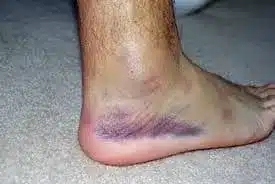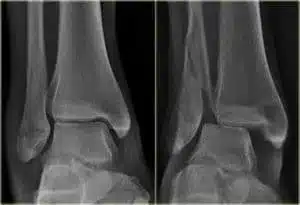If you’ve ever stepped on a large stone and sprained your ankle in the process, you know how painful it can be almost instantly. At that moment, you realize just how much of your total weight your ankle joint is responsible for supporting (up to 5 times your body weight with every step you take, in fact)!
Understanding Your Ankle Joint
Your ankle joint is formed by the connection of three bones
- The ankle bone (talus)
- The shin bone (tibia)
- The small bone of the lower leg (fibula)
The bottom part of the ankle bone or talus sits on the heel bone (calcaneus).
In addition to the bones forming your ankle, there are also numerous tendons and ligaments which help connect and protect the joint.
The most common ankle injuries are sprains and fractures, but arthritis can also be responsible for chronic ankle pain.
Sprained Ankle
Just what is a sprained ankle? The injury that occurs when you twist, roll or turn your ankle in an awkward way is known as a sprained ankle. What you’ve actually injured (by stretching or tearing) are the ligaments — the tough bands of fibrous tissue that help hold your ankle together and keep it stable. This can result in swelling plus ankle and foot pain and can make walking difficult, to say the least.
The BEST treatment is to immediately see your therapist at Rock Run Physical Therapy to apply supportive tape. We have seen in the clinic that this greatly reduces healing time. Other treatment may involve rest, alternating ice/heat therapy and over-the-counter pain medication to help reduce swelling and ease the pain. Bear in mind, though, that some strains can be quite severe, so if you’re in a great deal of pain or your ankle swells badly, you should see your doctor to have your injury evaluated as sometimes there is a small fracture involved. He or she might recommend further treatment including compression (an ace bandage) and physical therapy to help restore range of motion.

Broken Ankle
Fractures of the ankle are also common, and if you suspect you may have broken your ankle, you should seek immediate medical treatment. Symptoms of a fracture — whether it’s a partial or complete break — include
- Pain at the site of the break which can also radiate up towards the knee
- Significant swelling which is sometimes confined to the injured area, but can also extend up the leg
- Bruising that develops very quickly after your injury
- Change in appearance (The injured ankle looks noticeably different from the other ankle.)
- A bone that protrudes through the skin (an indication that the fracture is very serious and requires an immediate trip to the ER to prevent possible infection or other complications)

Never rely on the old advice that says that if you can walk on your injured ankle it’s not broken. It’s actually possible to walk on a bone with a slight fracture, so the “advice” is actually not a good indicator of the extent of your injury!
Treatment will depend on the severity of the fracture, with surgery being necessary for severe breaks. The doctor will likely immobilize your ankle via a brace or a cast, and rest and physical therapy will also likely be part of your recovery process.
Osteoarthritis of the Ankle
According to Arthritis-Health, osteoarthritis is a chronic condition that can affect your ankle by breaking down the cartilage and through the development of abnormal bony growths commonly known as bone spurs. Symptoms may be mild in the early stages, and you may notice ankle pain after a long walk or a run, and these symptoms can sometimes be dealt with simply by resting your elevated ankle and applying an ice pack.
However, arthritis is a progressive joint disease, and in time, it wears away cartilage, which results in the three bones that make up the ankle rubbing together and causing friction. This friction can cause ankle pain, general foot pain, swelling, stiffness, and popping or crunching noises.



